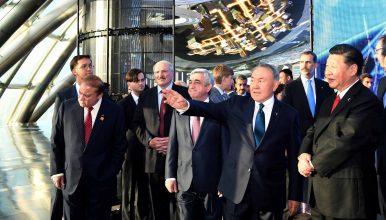 Given the dominance of conventional energy resources, are Astana’s green energy reforms merely publicity stunts?
Given the dominance of conventional energy resources, are Astana’s green energy reforms merely publicity stunts?
Kazakhstan’s President Nursultan Nazarbayev welcomed the New Year by touting key accomplishments of the past year, namely the Astana Expo 2017, which in his words granted the country more “global recognition and respect.” With its theme of “Future Energy,” the Expo demonstrated the Kazakh government’s purported commitment to green energy solutions as part of a broader national development strategy. However, the viability of such projects is limited, indicating a more immediate motive of projecting the image of a forward-looking Kazakhstan before Western audiences.
At the onset of the Expo, the government of Kazakhstan announced an economic transformation centered on sustainable development, greater foreign investment, and a push toward renewable energy. This was a remarkable statement given the fact that since independence Kazakhstan’s economy has been driven by the extractive industry, with oil accounting for 50 percent of the country’s GDP in 2017. Sitting on the 11th-largest proven oil reserves in the world, Kazakhstan’s abundant natural resource wealth has been the key to rapid development and enrichment of the state.
As a rentier state heavily dependent on the export of oil, Kazakhstan’s energy security is vulnerable to external economic shocks, such as the 2014 drop in oil prices. The sudden and drastic decrease of revenue signaled a vulnerability of the government, undermining its legitimacy as a provider of development and prosperity for the nation. The country also suffers from issues commonly associated with rentier states, such as economic growth that is not sustainable in the long term, a high level of corruption and inefficient management of resources, plus growing social inequality, as the oil sector often fails to create many jobs and suppresses the development of other sectors.
Kazakhstan has touted renewable energy as a viable solution to alleviate some of the country’s structural economic woes. In 2013, Kazakhstan adopted the “National Concept for Transition to a Green Economy up to 2050” outlining a future development path guided by green energy policies. The ambitious plan aims to increase the share of renewable energy in electric power generation to 30 percent by 2030 and 50 percent by 2050.
Currently, renewable sources (excluding hydropower) account for less than 1 percent of power produced in Kazakhstan. Both the government and independent observers attest that the potential for renewables is high. Foreign investors, such as the European Bank for Reconstruction and Development, are funding several high-profile pilot projects in the north and south of the country.
Structural realities in Kazakhstan cast serious doubt on how realistic these projects would be, considering the abundance of oil and other extractive resources, such as coal, which accounts for more than 80 percent of electricity generation. As part of the Kyoto Protocol, Kazakhstan vowed to reduce carbon emissions by 15 percent by 2020 and up to 30 percent by 2050. In spite of its relatively small population, the country is among the world’s leading emitter nations of greenhouse gases.
However, coal’s dominance of domestic energy production is most likely to persist in the near future, as ample reserves are projected to last for the next 150 years. Furthermore, the government plans to increase coal and oil production through 2030, casting some doubt on its commitments to reducing carbon emissions and seeking “cleaner” energy sources.
Kazakhstan also faces the challenge of meeting rising domestic demand for electricity which will soon surpass the capacity of its aging and highly inefficient infrastructure. Observers note that the domestic energy system functions with a reserve capacity below that considered secure and sustainable. Some estimates project that by 2022 demand will exceed supply at current prices. The overwhelming majority of Kazakhstan’s conventional power generation plants date back to Soviet times, with 85 percent of total power generation being more than 35 years old.
Electric power generation contributes to the overwhelming majority of the country’s air pollution, while outdated transmission networks account for estimated losses of 18 percent of energy produced during distribution, reaching 40 percent in some locations. In response to challenges related to rising energy inefficiency and demand, the government announced plans in 2013 aiming to reduce the energy intensity of the national economy by 25 percent through 2020.
Low electricity prices continue to be among the main drivers of energy policy in Kazakhstan. The government provides 60 percent subsidies to ensure low prices for domestic consumption; previous attempts to increase electricity tariffs have failed due to protests from minor enterprises and the general population. Abandoning conventional energy sources presents a risk leading to higher energy prices that would prove severely unpopular. In spite of appeals by government officials speaking to the urgency of developing renewable energy due to the volatility of oil prices, Kazakhstan has continued to pursue greater extraction of conventional energy sources.
Continued financial assistance from the national government is crucial in sustaining renewable energy projects. However, recent events have demonstrated that political will is not so certain, despite flashy campaigns meant to assert the government’s commitment to pursuing energy reform. Nazarbayev’s rhetoric concerning renewables has also been contradictory. At a meeting with Russian President Vladimir Putin in 2014, the Kazakh president was quoted as saying, “I personally do not believe in alternative energy sources, such as wind and solar.”
Current conditions dictate that conventional energy sources will continue to dominate domestic consumption and national exports into the near future, relegating current green energy reforms to publicity stunts and cursory gestures appealing to international norms. Furthermore, a shift to renewable energy would not alleviate Kazakhstan’s budgetary constraints, as these projects are intended mainly for domestic electricity consumption.
This still begs the question of how Kazakhstan will sustain economic growth once its natural resource reserves run out. It remains to be seen how the country’s long-term energy security policies will evolve once Nazarbayev is no longer in power, and how they will facilitate the president’s proclaimed vision to propel Kazakhstan amongst the world’s 30 most developed nations by 2050.
Andres Fernandez is a M.A. candidate in the Harriman Institute at Columbia University. His main areas of research include Russia-West relations, Hungary-Russia relations, and politics of the former Soviet Union.
Thediplomat.com, January 12, 2018




